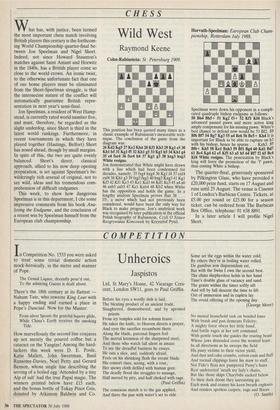CHESS
Wild West
Raymond Keene
What has, with justice, been termed the most important chess match involving British players this century is the forthcom- ing World Championship quarter-final be- tween Jon Speelman and Nigel Short. Indeed, not since Howard Staunton's matches against Saint Amant and Horwitz in the 1840s, has a British player come so close to the world crown. An ironic twist, to the otherwise unfortunate fact that one of our home players must be eliminated from the Short-Speelman struggle, is that the internecine nature of the conflict will automatically guarantee British repre- sentation in next year's semi-final.
Jon Speelman, a resident of West Hamp- stead, is currently rated world number five, and must, therefore, be regarded as the slight underdog, since Short is third in the latest world rankings. Furthermore, in recent tournaments in which they have played together (Hastings, Belfort) Short has nosed ahead, though by small margins. In spite of this, the two are quite evenly balanced. Short's direct, classical approach, allied to his now deep opening preparation, is set against Speelman's be- wilderingly rich arsenal of original, not to say wild, ideas and his tremendous com- prehension of difficult endgames.
This week, to show how dangerous Speelman is in this department, I cite some impressive comments from his book Ana- lysing the Endgame, and the conclusion of a recent win by Speelman himself from the European club championship. Cohn-Rubinstein: St Petersburg 1909.
This pos'tion has been quoted many times as a classic example of Rubinstein's inexorable tech- nique. The conclusion of the game from the diagram was: 26 Kd2 Kg5 27 Keg Kh4 28 Kfl Kh3 29 Kgl e5 30 Khl b5 31 Kgl f5 32 Khl g5 33 Kgl h5 34 Khl g4 35 e4 fxe4 36 fxe4 h4 37 Kgl g3 38 hxg3 hxg3 White resigns.
Jon demonstrated that White might have drawn with a line which had been condemned for decades, namely, 35 fxg4 hxg4 36 Kgl f4 37 exf4 exf4 38 Khl g3 39 fxg3 fxg3 40 hxg3 Kxg3 41 Kgl Kf3 42 Kfl Ke3 43 Kel lCd3 44 Kdl Kc3 45 a4 a6 46 axb5 axb5 47 Kcl Kxb4 48 Kb2 when White has the opposition and holds the game. In a lengthy analysis Speelman proves that 38 . . f3!, a move which had not previously been considered, would have been the only way for Black to make progress. Jon's analytical work was recognised by later publication in the official Polish biography of Rubinstein, Czyli 0 Sztuce Rozgrywania Koncowek by Krzysztof Pytel. Horvath-Speelman: European Club Cham- pionship, Rotterdam July 1988.
Speelman wore down his opponent in a compli- cated quadruple bishop endgame as follows:
50 Bh4 Bh5+ 51 Kg2 13+ 52 Kfl Kf4 Black's advanced passed pawn and more active king amply compensate for his missing pawn. White's best chance to defend now would be 53 Be. 53 Bf6 Bf7 54 Bg7 Kg3 55 a4 Be6 56 BeS+ Kh4 It is important for Black to be able to capture on h3 with his bishop, hence he spurns . . . Kxh3. 57 Bf6+ 1Ch5 58 Kel Bxh3 59 Bfl Bg4 60 Kdl Bd7 61 Bc4 Kg4 62 e5 Kf5 63 a5 h5 64 Bf7 f2 65 Bc4 Kf4 White resigns. The penetration by Black's king will force the promotion of the T pawn, thus costing White a bishop.
The quarter-final, generously sponsored by Pilkington Glass, who have provided a £20,000 prize fund, starts on 17 August and runs until 25 August. The venue is Cinema 1 of London's Barbican Centre. Tickets, at £5.00 per round or £25.00 for a season ticket, can be ordered from The Barbican Box Office, telephone: 01 638 8891.
In a later article I will profile Nigel Short.














































 Previous page
Previous page